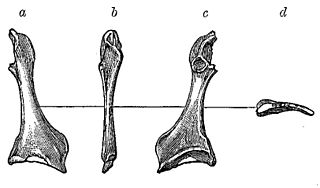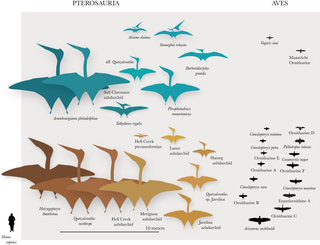
Charadriiformes is a diverse order of small to medium-large birds. It includes about 390 species and has members in all parts of the world. Most charadriiform birds live near water and eat invertebrates or other small animals; however, some are pelagic (seabirds), others frequent deserts, and a few are found in dense forest. Members of this group can also collectively be referred to as shorebirds.

Laridae is a family of seabirds in the order Charadriiformes that includes the gulls, terns, noddies, skimmers, and kittiwakes. It includes around 100 species arranged into 22 genera. They are an adaptable group of mostly aerial birds found worldwide.

The suborder Lari is the part of the order Charadriiformes that includes the gulls, terns, skuas and skimmers; the rest of the order is made up of the waders and snipes. The auks are now placed into the Lari too, following recent research. Sometimes, the buttonquails are also placed here, but the molecular data and fossil record rather suggests they are a quite basal offshoot along with the snipe-like and aberrant waders.

The Maastrichtian is, in the ICS geologic timescale, the latest age of the Late Cretaceous Epoch or Upper Cretaceous Series, the Cretaceous Period or System, and of the Mesozoic Era or Erathem. It spanned the interval from 72.1 to 66 million years ago. The Maastrichtian was preceded by the Campanian and succeeded by the Danian.

The evolution of birds began in the Jurassic Period, with the earliest birds derived from a clade of theropod dinosaurs named Paraves. Birds are categorized as a biological class, Aves. For more than a century, the small theropod dinosaur Archaeopteryx lithographica from the Late Jurassic period was considered to have been the earliest bird. Modern phylogenies place birds in the dinosaur clade Theropoda. According to the current consensus, Aves and a sister group, the order Crocodilia, together are the sole living members of an unranked reptile clade, the Archosauria. Four distinct lineages of bird survived the Cretaceous–Paleogene extinction event 66 million years ago, giving rise to ostriches and relatives (Palaeognathae), waterfowl (Anseriformes), ground-living fowl (Galliformes), and "modern birds" (Neoaves).
Eurolimnornis is the name given to a monotypic genus of pterosaurs from the Early Cretaceous. The only known species E. corneti probably was originally identified as a primitive but essentially modern bird, although alternative theories later suggested that it was a non-avialan theropod or pterosaur. The identification as a pterosaur was supported by a re-evaluation of the fossil remains published in 2012.

Gansus is a genus of aquatic birds that lived during the Aptian age of the Early Cretaceous (Aptian-Albian) period in what are now Gansu and Liaoning provinces, western China. The rock layers from which their fossils have been recovered are dated to 120 million years ago. It was first described in 1984 on the basis of an isolated left leg. It is the oldest-known member of the Ornithurae, the group which includes modern birds (Neornithes) and extinct related groups, such as Ichthyornis and Hesperornithes.

Presbyornis is an extinct genus of anseriform bird. It contains two unequivocally accepted species; the well-known P. pervetus and the much lesser-known P. isoni. P. pervetus was approximately the size and shape of a goose, but with longer legs; P. isoni, known from a few bones, was much larger, more than swan-sized. Other fossils, more doubtfully assigned to this genus, are also known.
Polarornis is a genus of prehistoric bird, possibly an anserimorph. It contains a single species Polarornis gregorii, known from incomplete remains of one individual found on Seymour Island, Antarctica, in rocks which are dated to the Late Cretaceous.

Longipteryx is a genus of prehistoric bird which lived during the Early Cretaceous. It contains a single species, Longipteryx chaoyangensis. Its remains have been recovered from the Jiufotang Formation at Chaoyang in Liaoning Province, China. Apart from the holotype IVPP V 12325 - a fine and nearly complete skeleton — another entire skeleton and some isolated bones are known to date.
Piksi is a potential pterosaur genus containing the single species Piksi barbarulna. It lived roughly 75 million years ago in what is now Montana, United States. Known from parts of a right wing – the humerus, ulna and radius bones – the only specimens found so far are housed in the Museum of the Rockies. The genus Piksi is monotypic at present.
Scaniornis is a prehistoric bird genus. The only known species, Scaniornis lundgreni, lived in the MP 1–5.
Torotix is a Late Cretaceous genus of aquatic birds. They lived along the shores of the Western Interior Seaway, but it is not clear whether they were seabirds or freshwater birds, as the genus is only known from a humerus. Consequently, the genus contains only one known species, Torotix clemensi. T. clemensi is represented by a single fossil specimen, a partial humerus recovered from the Lance formation of Wyoming. Its deposits are dated to the very end of the Cretaceous period, 66 million years ago.
Gallornis is a genus of prehistoric birds from the Cretaceous. The single known species Gallornis straeleni lived near today's Auxerre in Yonne département (France); it has been dated very tentatively to the Berriasian-Hauterivian stages, that is about 140–130 million years ago. The known fossil material consists of a worn partial femur and a fragment of the humerus.

Cimolopteryx is a prehistoric bird genus from the Late Cretaceous Period. It is currently thought to contain only a single species, Cimolopteryx rara. The only specimen confidently attributed to C. rara was found in the Lance Formation of Wyoming, dating to the end of the Maastrichtian age, which ended about 66 million years ago. The dubious species "Cimolopteryx" maxima has been described from both the Lance Formation and the Hell Creek Formation of Montana. The humeral end of a left coracoid from the Frenchman Formation of southern Saskatchewan has also been attributed to the genus.

Ceramornis is a prehistoric bird genus from the Late Cretaceous. It lived shortly before the Cretaceous–Paleogene extinction event in the Maastrichtian, some 66 million years ago (mya). Its remains were found in the Lull 2 location, a Lance Formation site in Niobrara County, Wyoming. A single species is known, Ceramornis major, and even that only from a proximal piece of coracoid. This is specimen UCMP V53957, which was collected by a University of California team in 1958.

Palintropus is a prehistoric bird genus from the Late Cretaceous. A single species has been named based on a proximal coracoid from the Lance Formation of Wyoming, dated to the latest Maastrichtian, 66 million years ago. Coracoids and a proximal scapula of two unnamed species from the upper Campanian Dinosaur Park Formation of Alberta, dating to between 76.5 and 75 million years ago, are also known.
Apsaravis is a Mesozoic bird genus from the Late Cretaceous. The single known species, Apsaravis ukhaana, lived about 78 million years ago, in the Campanian age of the Cretaceous period. Its fossilized remains were found in the Camel's Humps sublocality of the Djadokhta Formation, at Ukhaa Tolgod in the Gobi Desert of Mongolia. They were collected in the 1998 field season by the Mongolian Academy of Sciences/American Museum of Natural History Paleontological Expeditions. It was described by Norell and Clarke (2001).
Palaeotringa is a prehistoric bird genus that was discovered by O. C. Marsh during the late 19th century American bone wars. Its remains were found in the controversial Hornerstown Formation of New Jersey which straddles the Cretaceous-Paleocene boundary some 66 million years ago. Though it cannot be said if these birds lived before or after the Cretaceous–Paleogene extinction event, they were in all likelihood wading birds that inhabited the coasts of the northwestern Atlantic.

Miodytes is a fossil genus of grebe known from a nearly complete specimen from Valjevo Basin, western Serbia known from an almost complete right wing skeleton. It contains a single species, M. serbicus.













